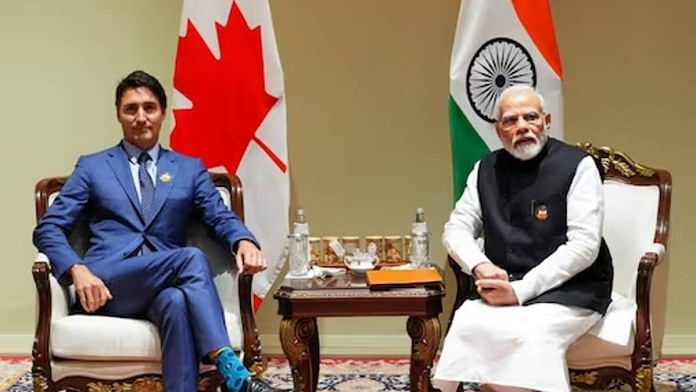New Delhi: The fracas over the withdrawal of Canadian diplomats from India has seen both governments invoke the Vienna Convention on Diplomatic Relations, an agreement that codifies crucial aspects of international law, serves as a framework for diplomacy between independent countries and lays down diplomatic immunity privileges.
Ottawa, which withdrew 41 diplomats and updated its advisory for travel to India Friday, has accused New Delhi of violating international law.
“I can confirm that India has formally conveyed its plan to unilaterally remove diplomatic immunity for all but 21 Canadian diplomats and dependents in New Delhi by tomorrow, 20 October… Given the implications of India’s actions on the safety of our diplomats, we have facilitated their safe departure from India. This means that our diplomats and their families have now left,” Canada’s foreign affairs minister Mélanie Joly had said at a press conference Thursday.
Joly labelled India’s ultimatum a violation of international law and the Vienna Convention, and said Canada would not be retaliating.
“If we allow the norm of diplomatic immunity to be broken, no diplomats anywhere on the planet would be safe. So for this reason, we will not reciprocate,” Joly was quoted as saying about the status of Indian diplomats in Canada.
India’s Ministry of External Affairs put out a statement Friday responding with concern over Canadian “interference” in India’s affairs, and directly quoted Article 11.1 of the Vienna Convention, which is as follows:
“In the absence of specific agreement as to the size of the mission, the receiving State may require that the size of a mission be kept within limits considered by it to be reasonable and normal, having regard to circumstances and conditions in the receiving state and to the needs of the particular mission.”
Article 11.2 of the convention says the receiving country may “refuse to accept officials” as long as it remains “within similar bounds and on a non-discriminatory basis”.
“We reject any attempt to portray the implementation of parity as a violation of international norms,” the ministry said.
Speaking at the Kautilya Economic Conclave in New Delhi Sunday, Union Minister of External Affairs S. Jaishankar reiterated concerns about Canadian “interference” in Indian affairs, and said that India was following the Vienna Convention by prioritising safety and security.
“There’s this whole issue of parity between…how many diplomats there are of one country versus how many diplomats there are of the other country. Parity is very much provided for by the Vienna Convention, which is the relevant international rule on this. But in our case, we invoked parity because we had concerns about continuous interference in our affairs by Canadian personnel. We haven’t made much of that public,” Jaishankar said.
The US and the UK have come out in support of Canada’s withdrawal, with the US Department of State urging India “not to insist upon a reduction in Canada’s diplomatic presence and to cooperate in the ongoing Canadian investigation”, and the UK expressing disagreement with “decisions taken by the Indian government”.
ThePrint takes a look at the Vienna Convention, which is now at the heart of this row.
Also Read: No Canadian diplomat has left India so far, talks on parity an ‘ongoing process’ with no deadline
What does Vienna Convention do?
With the goal of developing “friendly relations among nations”, the 53-article Vienna Convention on Diplomatic Relations emphasises diplomatic immunity for the purposes of efficient performance of diplomatic missions, rather than for the benefit of particular individuals.
As such, the convention not only defines each aspect of a diplomatic mission but also details its primary functions — representation, protection of interests, negotiation, ascertaining and reporting on-ground developments, and promoting friendly relations.
“Although the Vienna conventions could never perfect the practice of diplomatic relations, politicians and diplomats alike had high hopes that the Vienna Convention could help avoid friction via the codification of established rules, and the clarification of those aspects of law where universal practice had yet to be established,” academic Kai Bruns writes in his 2014 book, A Cornerstone of Modern Diplomacy: Britain and the Negotiation of the 1961 Vienna Convention on Diplomatic Relations.
History and interpretations
A brainchild of the United Nations’ International Law Commission, the Vienna Convention on Diplomatic Relations was adopted on 18 April, 1961, and signed by 60 UN member states before coming into effect on 24 April, 1964. Today, 193 states are parties to the convention.
The adoption came at a significant period for global diplomacy, amid the Cold War and the erection of the Berlin Wall, according to Bruns.
“The early 1960s were years of contest and mutual distrust which was reflected in general suspicion and a loaded international atmosphere,” Bruns writes in his book.
Canada was one of the early signatories to the convention, doing so on 5 February, 1962, and ratifying it on 26 May, 1966. India was not one of the original signatories but ratified the convention on 15 October, 1965.
While India invoked Article 11.1 Friday, the most relevant article of the convention to the India-Canada controversy is Article 9, which concerns diplomatic officials considered persona non grata, meaning an unacceptable or unwelcome individual, by the receiving country.
“The receiving State may at any time and without having to explain its decision, notify the sending State that the head of the mission or any member of the diplomatic staff of the mission is persona non grata or that any other member of the staff of the mission is not acceptable. In any such case, the sending State shall, as appropriate, either recall the person concerned or terminate his functions with the mission. A person may be declared non grata or not acceptable before arriving in the territory of the receiving State,” says Article 9.1.
(Edited by Nida Fatima Siddiqui)
Also Read: Justin Trudeau’s 15 seconds of fame—undoing two decades of India-Canada rebuilding ties



